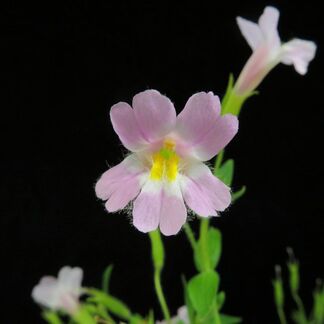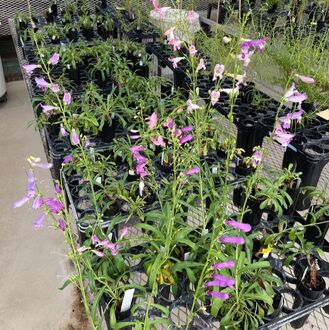We use lots of different research tools to understand how flower shape evolves. For example, we use phylogenetic methods to understand flower trait evolution, morphological/histological methods to determine how cell size and shape affects overall flower form, quantitative genetic and genomic methods to link genotype to flower phenotype, transcriptomic and other gene expression methods to discover genes involved in various aspects of flower development, and functional assays like RNA interference and more recently CRISPR to test how specific gene products pattern flower development.
Overall, we aim to better understand
Here are some highlights
Overall, we aim to better understand
- the genetic changes responsible for evolutionary transitions in floral form.
- the extent to which parallel flower trait evolution results from parallel genetic changes.
- how developmental programs are conserved and in what ways have they diversified during flowering plant evolution—especially following gene duplication and gene loss events.
Here are some highlights

We study conservation and diversification of the CYCLOIDEA-dependant flower symmetry developmental program across eudicots and monocots. We are particularly interested in how evolutionary changes in the program shape flower diversity.
Current projects:
Relevant publications:
Current projects:
- Gene expression, RNA interference and CRISPR approaches in Mimulus lewisii (pictured) to expand our knowledge of the flower symmetry program.
Relevant publications:
- Dunivant, T.S., Singh, V., Livingston, K.E., Ross, J.D., Hileman, L.C. 2024. CYCLOIDEA paralogs function partially redundantly to specify dorsal flower development in Mimulus lewisii. American Journal of Botany 111(2):e16271. https://doi.org/10.1002/ajb2.16271
- Sengupta, A., Hileman, L.C. 2022. A CYC–RAD–DIV–DRIF interaction likely pre-dates the origin of floral monosymmetry in Lamiales. EvoDevo 13, 3. doi: 10.1186/s13227-021-00187-w
- Sengupta, A., Hileman, L.C. 2018. Novel traits, flower symmetry, and transcriptional autoregulation: new hypotheses from bioinformatic and experimental data. Frontiers in Plant Science 9:1561 doi: 10.3389/fpls.2018.01561.
- Zhong, J., Preston, J.C., Hileman, L.C., Kellogg, E.A. 2017. Repeated and diverse losses of corolla bilateral symmetry in the Lamiaceae. Annals of Botany 119:21211-1223 doi: 10.1093/aob/mcx012.
- Preston, J.C., Barnett, L.L., Kost, M.A., Oborny, N.J., Hileman, L.C. 2014. Optimization of virus-induced gene silencing to facilitate evo-devo studies in the emerging model species Mimulus guttatus DC. (Phrymaceae). Annals of the Missouri Botanical Garden 99:301-312. doi: 10.3417/2010120.
- Hileman, L.C. 2014. Trends in flower symmetry evolution revealed through phylogenetic and developmental genetic advances. Philosophical Transactions of the Royal Society B 369:20130348. doi: 10.1098/rstb.2013.0348.
- Hileman, L.C. 2014. Bilateral flower symmetry – how, when and why? Current Opinion in Plant Biology 17:146-152. doi: 10.1016/j.pbi.2013.12.002.
- Preston, J.C., Hileman, L.C. 2012. Parallel evolution of TCP and B-class genes in Commelinaceae flower bilateral symmetry. EvoDevo 3:6. doi: 10.1186/2041-9139-3-6.
- Preston, J.C., Martinez, C.C., and Hileman, L.C. 2011. Gradual disintegration of the floral symmetry gene network is implicated in the evolution of a wind-pollination syndrome. Proceedings of the National Academy of Sciences, USA 108(6):2343-2348. doi: 10.1073/pnas.1011361108.
- Preston, J.C., Kost, M.A., and Hileman, L.C. 2009. Conservation and diversification of the symmetry developmental program among close relatives of snapdragon with divergent floral morphologies. New Phytologist 182(3):751-762. doi: 10.1111/j.1469-8137.2009.02794.x.
- Preston, J.C., and Hileman, L.C. 2009. Developmental genetics of floral symmetry evolution. Trends in Plant Science 14(3):147-154. doi: 10.1016/j.tplants.2008.12.005.
- Hileman, L.C., Kramer, E.M., and Baum, D.A. 2003. Differential regulation of symmetry genes and the evolution of floral morphologies. Proceedings of the National Academy of Sciences, USA 100(22):12814-12819. doi: 10.1073/pnas.1835725100.
- Hileman, L.C., and Baum, D.A. 2003.Why do paralogs persist? Molecular evolution of CYCLOIDEA and related floral symmetry genes in Antirrhineae (Veronicaceae). Molecular Biology and Evolution 20(4):591-600. doi: 10.1093/molbev/msg063.

We study the evolution of floral traits in Penstemon, the largest North American flowering plant genus. During Penstemon diversification, species with flowers adapted to hummingbird pollination have evolved multiple times from the ancestral condition of bee-adaptation. This parallel evolution of hummingbird adaptation provides a framework for addressing a number of exciting evolutionary and genetic questions.
Current projects:
Our work in Penstemon is in collaboration with Dr. John Kelly (University of Kansas) and Dr. Carolyn Wessinger (University of South Carolina)
Relevant publications:
Current projects:
- Predicting complex trait divergence from genomic signatures.
- Quantitative genetic, genomic and transcriptomic approaches to discover whether parallel trait evolution results from parallel developmental and genetic processes.
- Build genetic and genomic resources to advance Penstemon as a model species for ecological and evolutionary research.
Our work in Penstemon is in collaboration with Dr. John Kelly (University of Kansas) and Dr. Carolyn Wessinger (University of South Carolina)
Relevant publications:
- Wessinger, C.A., Katzer, A.M., Hime, P. Rausher, M.D., Kelly J.K., Hileman, L.C. 2023. A few essential genetic loci distinguish Penstemon species with flowers adapted to pollination by bees or hummingbirds. PLOS Biology. https://doi.org/10.1371/journal.pbio.3002294
- Wessinger, C.A. Katzer, A.M., Hime, P. Rausher, M.D., Kelly, J.K., Hileman, L.C. 2023. A few essential genetic loci distinguish Penstemon species with flowers adapted to pollination by bees or hummingbirds. PLOS Biology.
- Wessinger, C.A., Rausher, M.D., Hileman, L.C. 2019. Adaptation to hummingbird pollination is associated with reduced diversification in Penstemon. Evolution Letters 3(5):521-533 doi: 10.1002/evl3.130
- Katzer, A.M., Wessinger, C.A., Hileman, L.C. 2019. Nectary size is a pollination syndrome trait in Penstemon. New Phytologist 223:377-384 doi: 10.1111/nph.15769
- Wessinger, C.A., Kelly, J.K., Jiang, P. Rausher, M.D., Hileman, L.C. 2018. SNP-skimming: A fast approach to map loci generating quantitative variation in natural populations. Molecular Ecology Resources 18. doi: 10.1111/1755-0998.12930
- Wessinger, C.A., Hileman, L.C. 2016. Accessibility, constraint, and repetition in adaptive floral evolution. Developmental Biology 419:175-183. doi: 10.1016/j.ydbio.2016.05.003.
- Wessinger, C.A., Freeman, C.C., Mort, M.E., Rausher, M.D., Hileman, L.C. 2016. Multiplexed shotgun genotyping resolves species relationships within the recently radiated North American genus Penstemon. American Journal of Botany 103:912-922. doi: 10.3732/ajb.1500519.
- Wessinger, C.A., Hileman, L.C.*, Rausher, M.D.* 2014. Identification of major QTLs underlying floral pollination syndrome divergence in Penstemon. Philosophical Transactions of the Royal Society B 369:20130349. doi: 10.1098/rstb.2013.0349.